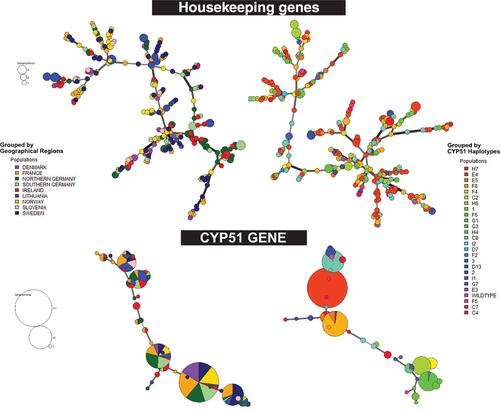当前位置:
X-MOL 学术
›
Pest Manag. Sci.
›
论文详情
Our official English website, www.x-mol.net, welcomes your
feedback! (Note: you will need to create a separate account there.)
DMI fungicide resistance in Zymoseptoria tritici is unlinked to geographical origin and genetic background: a case study in Europe
Pest Management Science ( IF 3.8 ) Pub Date : 2024-11-06 , DOI: 10.1002/ps.8514 Eula Gems Oreiro, Berit Samils, Steven Kildea, Thies Heick, Pierre Hellin, Anne Legrève, Bernd Rodemann, Gunilla Berg, Lise N Jørgensen, Hanna Friberg, Anna Berlin, Jiasui Zhan, Björn Andersson
Pest Management Science ( IF 3.8 ) Pub Date : 2024-11-06 , DOI: 10.1002/ps.8514 Eula Gems Oreiro, Berit Samils, Steven Kildea, Thies Heick, Pierre Hellin, Anne Legrève, Bernd Rodemann, Gunilla Berg, Lise N Jørgensen, Hanna Friberg, Anna Berlin, Jiasui Zhan, Björn Andersson

|
BACKGROUNDThe hemibiotrophic fungus Zymoseptoria tritici causing Septoria tritici blotch (STB), is a devastating foliar pathogen of wheat worldwide. A common group of fungicides used to control STB are the demethylation inhibitors (DMIs). DMI fungicides restrict fungal growth by inhibiting the sterol 14‐α‐demethylase, a protein encoded by CYP51 gene and essential for maintaining fungal cell permeability. However, the adaptation of Z. tritici populations in response to intensive and prolonged DMI usage has resulted in a gradual shift towards reduced sensitivity to this group of fungicides. In this study, 311 isolates were collected pre‐treatment from nine wheat‐growing regions in Europe in 2019. These isolates were analysed by high‐throughput amplicon‐based sequencing of nine housekeeping genes and the CYP51 gene.RESULTSAnalyses based on housekeeping genes and the CYP51 gene revealed a lack of population structure in Z. tritici samples irrespective of geographical origin. Minimum spanning network (MSN) analysis showed clustering of multilocus genotypes (MLGs) based on CYP51 haplotypes, indicating an effect of selection due to DMI fungicide use. The majority of the haplotypes identified in this study have been reported previously. The diversity and frequencies of mutations varied across regions.CONCLUSIONUsing a high‐throughput amplicon‐sequencing approach, we found several mutations in the CYP51 gene combined in different haplotypes that are likely to cause fungicide resistance. These mutations occurred irrespective of genetic background or geographical origin. Overall, these results contribute to the development of effective and sustainable risk monitoring for DMI fungicide resistance. © 2024 The Author(s). Pest Management Science published by John Wiley & Sons Ltd on behalf of Society of Chemical Industry.
中文翻译:

Zymoseptoria tritici 的 DMI 杀菌剂耐药性与地理起源和遗传背景无关:欧洲案例研究
背景引起 Septoria tritici 斑点 (STB) 的半生物营养真菌 Zymoseptoria tritici 是世界范围内小麦的一种毁灭性叶面病原体。用于控制 STB 的一组常见杀菌剂是去甲基化抑制剂 (DMI)。DMI 杀菌剂通过抑制甾醇 14-α-脱甲基酶来限制真菌生长,甾醇 14--脱甲基酶是一种由 CYP51 基因编码的蛋白质,对于维持真菌细胞通透性至关重要。然而,Z. tritici 种群对 DMI 的密集和长期使用进行了适应,导致对这组杀菌剂的敏感性逐渐降低。在这项研究中,2019 年从欧洲 9 个小麦种植区收集了 311 株预处理分离株。通过对 9 个看家基因和 CYP51 基因进行基于扩增子的高通量测序来分析这些分离株。结果基于管家基因和 CYP51 基因的分析显示,无论地理起源如何,Z. tritici 样本都缺乏种群结构。最小跨度网络 (MSN) 分析显示基于 CYP51 单倍型的多位点基因型 (MLG) 聚类,表明由于 DMI 杀菌剂的使用而产生选择的影响。本研究中确定的大多数单倍型之前已经报道过。突变的多样性和频率因地区而异。结论采用高通量扩增子测序方法,我们发现 CYP51 基因的几个突变以不同的单倍型组合而成,这些突变可能导致杀菌剂耐药性。这些突变的发生与遗传背景或地理起源无关。总体而言,这些结果有助于开发有效和可持续的 DMI 杀菌剂耐药性风险监测。© 2024 作者。 由John Wiley & Sons Ltd代表化学工业协会出版的《害虫管理科学》。
更新日期:2024-11-06
中文翻译:

Zymoseptoria tritici 的 DMI 杀菌剂耐药性与地理起源和遗传背景无关:欧洲案例研究
背景引起 Septoria tritici 斑点 (STB) 的半生物营养真菌 Zymoseptoria tritici 是世界范围内小麦的一种毁灭性叶面病原体。用于控制 STB 的一组常见杀菌剂是去甲基化抑制剂 (DMI)。DMI 杀菌剂通过抑制甾醇 14-α-脱甲基酶来限制真菌生长,甾醇 14--脱甲基酶是一种由 CYP51 基因编码的蛋白质,对于维持真菌细胞通透性至关重要。然而,Z. tritici 种群对 DMI 的密集和长期使用进行了适应,导致对这组杀菌剂的敏感性逐渐降低。在这项研究中,2019 年从欧洲 9 个小麦种植区收集了 311 株预处理分离株。通过对 9 个看家基因和 CYP51 基因进行基于扩增子的高通量测序来分析这些分离株。结果基于管家基因和 CYP51 基因的分析显示,无论地理起源如何,Z. tritici 样本都缺乏种群结构。最小跨度网络 (MSN) 分析显示基于 CYP51 单倍型的多位点基因型 (MLG) 聚类,表明由于 DMI 杀菌剂的使用而产生选择的影响。本研究中确定的大多数单倍型之前已经报道过。突变的多样性和频率因地区而异。结论采用高通量扩增子测序方法,我们发现 CYP51 基因的几个突变以不同的单倍型组合而成,这些突变可能导致杀菌剂耐药性。这些突变的发生与遗传背景或地理起源无关。总体而言,这些结果有助于开发有效和可持续的 DMI 杀菌剂耐药性风险监测。© 2024 作者。 由John Wiley & Sons Ltd代表化学工业协会出版的《害虫管理科学》。


















































 京公网安备 11010802027423号
京公网安备 11010802027423号